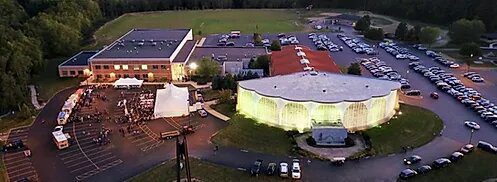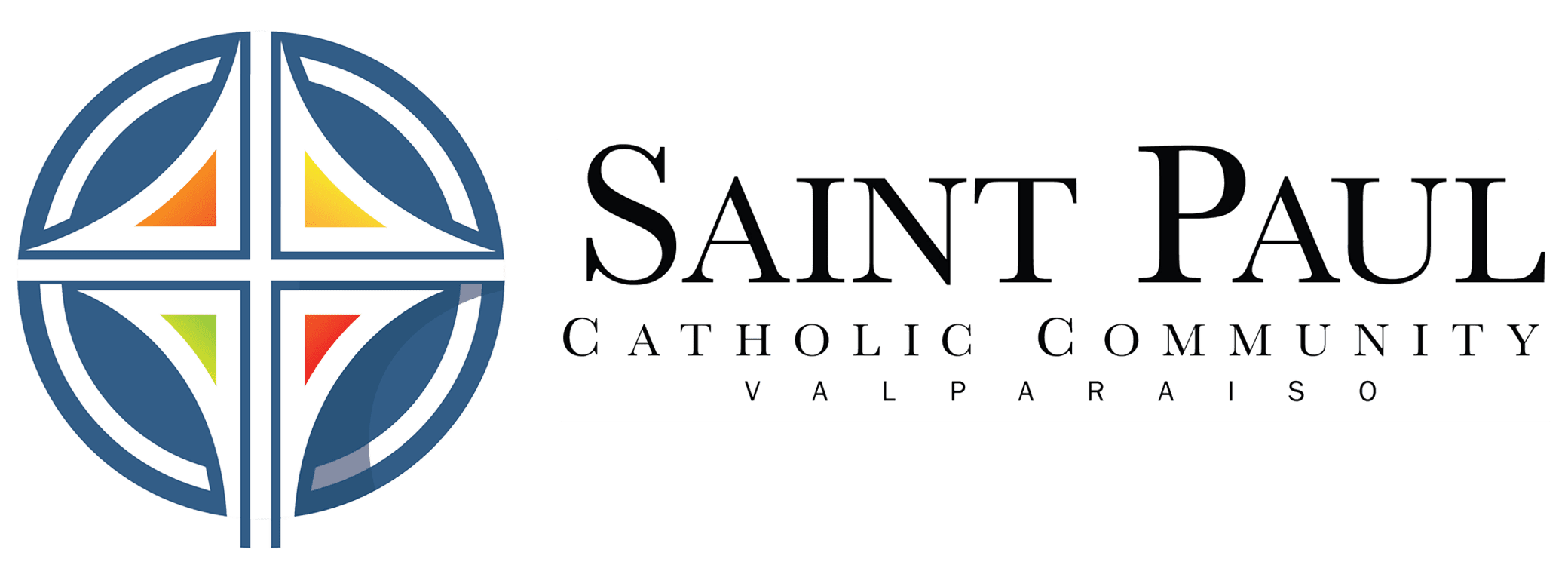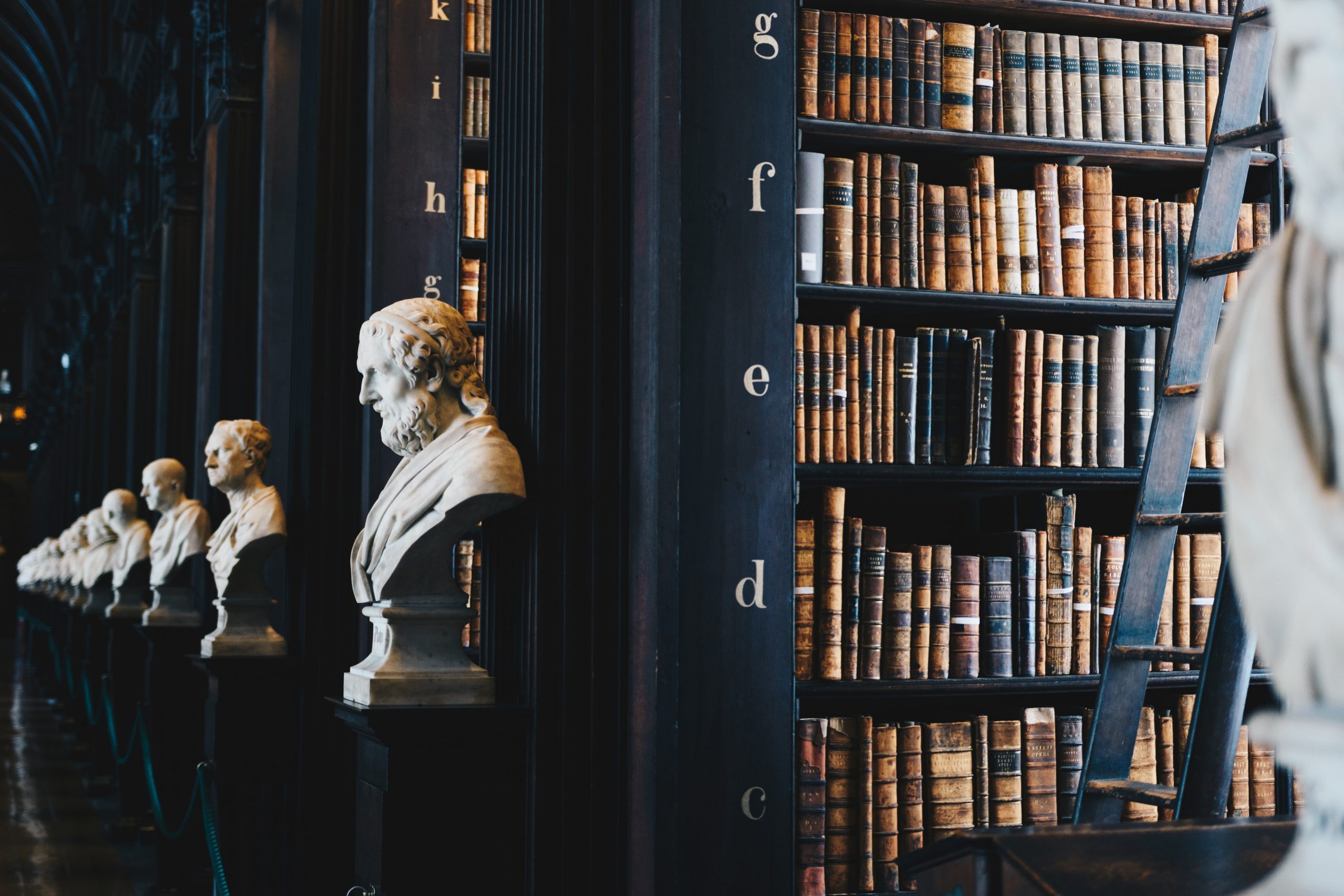Early Beginnings
Much of the early life in the community may be identified by the building of the railroads through Valparaiso. The Irish and French came to the area as part of the railroad construction. The result was the little parish of Saint Paul, ministering to about 200 families.
The first Mass was celebrated in the 1850’s at the P.T. Clifford farm, usually held outdoors. Between 1853 and 1857 Holy Cross priests from Notre Dame came to serve the people. Fathers Cointet, J. Curley, E.B. Kilroy, E. LeVeque and Paul Gillen came to serve. The latter served as pastor from 1857 to June 1858 and it was through his efforts that Saint Paul Parish was established and named in honor of him and the Apostle Paul.
Fr. Paul left before the church building was completed and for a time, no efforts were made to finish the building or to hold regular services. Sometimes Mass was offered in the courthouse and in the David Barry Blacksmith Shop on Indiana Avenue.
Much of the early life in the community may be identified by the building of the railroads through Valparaiso. The Irish and French came to the area as part of the railroad construction. The result was the little parish of Saint Paul, ministering to about 200 families.
The first Mass was celebrated in the 1850’s at the P.T. Clifford farm, usually held outdoors. Between 1853 and 1857 Holy Cross priests from Notre Dame came to serve the people. Fathers Cointet, J. Curley, E.B. Kilroy, E. LeVeque and Paul Gillen came to serve. The latter served as pastor from 1857 to June 1858 and it was through his efforts that Saint Paul Parish was established and named in honor of him and the Apostle Paul.
Fr. Paul left before the church building was completed and for a time, no efforts were made to finish the building or to hold regular services. Sometimes Mass was offered in the courthouse and in the David Barry Blacksmith Shop on Indiana Avenue.
In 1857 Fr. Joseph Luers was named Bishop of Northern Indiana. One of his first acts was to place a resident priest in Valparaiso. Fr. John Force served from July 1858 to December 1858. He helped complete the first church. It was a humble wooden clapboard building, 110×50 feet with only planks laid over the joists for a floor. The cost to build was $2000. The first baptisms recorded were on July 3, 1858 and the first marriage joined John Carver and Sarah Dawn Carver on November 15, 1858.Image
In 1857 Fr. Joseph Luers was named Bishop of Northern Indiana. One of his first acts was to place a resident priest in Valparaiso. Fr. John Force served from July 1858 to December 1858. He helped complete the first church. It was a humble wooden clapboard building, 110×50 feet with only planks laid over the joists for a floor. The cost to build was $2000. The first baptisms recorded were on July 3, 1858 and the first marriage joined John Carver and Sarah Dawn Carver on November 15, 1858.

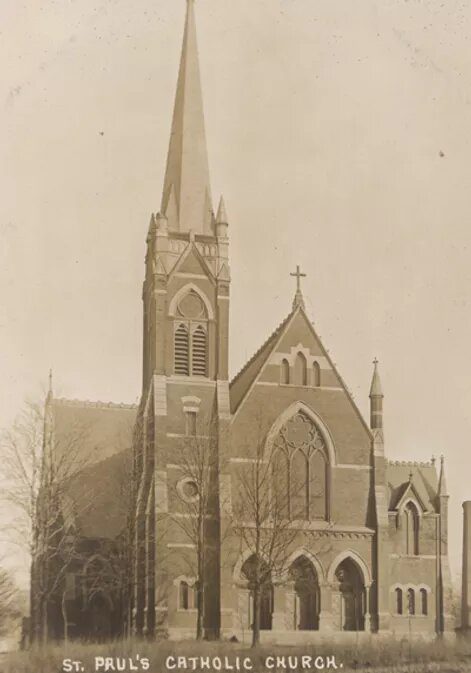
Building Community
Upon his arrival, Fr. O’Reilly found the church closed under an injunction; debts unpaid, no residence, no school, nothing to encourage the organization of the congregation. O’Reilly went house to house to tell the people he was the new pastor. He rented a hall to hold Mass for $2.00 a Sunday.
On Easter Sunday 1863, he first secured the old church which was badly in need of repairs. When finished, he opened it for a school. This was the beginning of Saint Paul Catholic School. In that same year he purchased an acre of ground, the site on which a future church and school would be built for $1,800.In 1870 the pastoral residence was erected at a cost of $6,000. The residence was continually used to house the pastoral team at Saint Paul’s until June of 2018.
With three teachers, the first official school was opened in September 1872. The cost to build the new Saint Paul Academy was $9,000. Realizing the need for more teachers, Fr. O’Reilly secured the services of the Sisters of Providence from Saint Mary of the Woods in Terre Haute, Indiana. The Sisters taught core academic subjects as well as music, drawing, painting, and fine needlework. Under Father O’Reilly’s guidance, the school grew and expanded it’s offerings to include a choir, band, fife and drum corps, drama club, and other extracurricular programs. The Sisters of the Holy Cross, CSC, came in 1901 to teach at the St. Paul School at the invitation of Reverend Louis A. Moench, Pastor. There were four sisters in the original group, Sister M. Eulalie O’Brian, CSC, Directress, Sister M. Andre Pidgeon, CSC, Sister M. Cecil Didier, CSC, and Sister M. Thomasina Cullinane, CSC. The Sisters of the Holy Cross, CSC, provided teachers from 1901 to 1988. They faithfully taught in two school buildings– the four-room schoolhouse on Chicago Street, and the newer school erected in 1951. Sisters M. Deborah, Sister M. Lourdes, Sister Mary Katherine, and Sister M. Aloysia remained until the Sisters of the Holy Cross ended their 87 year of ministry at the Saint Paul School at the end of the 1987-1988 academic year, due to a shortage of sisters to provide teachers to St. Paul School. Sisters Judith Ann Murphy, CSC, became a Sister of Holy Cross from St. Paul Parish in 1958. She also served St. Paul Parish in Religious Education, and currently resides at St. Mary’s Convent, South Bend, Indiana.
The cornerstone for the second Saint Paul Church was laid by Bishop Dwenger on October 8, 1883. The total cost to build was $65,000. The new gothic-style church had only been completed for ten months when Father O’Reilly passed away on August 4, 1887. Father Joseph Kroll served as pastor for three weeks before Fr. John Dempsey became the new pastor until May 1898.
Father Willam Hogan served as pastor from 1903 to 1915. In 1904 an additional half lot was bought, cement walks were installed and further supplies for the school were purchased. The building had a fine basement used as a club room for the young men; the main floor had three school rooms with a large hall on the second floor, and a special room for society meetings and a library. The school taught eight grades and was conducted by three Sisters of Notre Dame and was attended by 77 pupils.
In 1904 there were 140 families, numbering 800 souls as members of Saint Paul Church. Six baptisms and four marriages took place that year.Father E. J. Mungovan served as pastor from 1915 to 1929. Following him, Father John Sullivan served as pastor until 1942. Father Fracis Guerre served as pastor from 1942 until 1947.
According to the 1944 Saint Paul Financial Report, total receipts were $26,454.75. During that year there were seven funerals, 56 baptisms, and 30 first communions. There were close to 400 families as members and the school had 145 children. In total, the parish had over 1,200 souls as members. In that year Walter Woycik and Paul Mayer were two Saint Paul men who gave their lives in WWII. The financial report gave an individual listing of all Saint Paul members and their annual giving totals.Fr. Raymond Derrick served as pastor from 1947 to 1958
Construction on a new Saint Paul School began in July 1950 by the Roy Clark Company of East Chicago. Fr. Derrick and Fr. White blessed the structure during the laying of the cornerstone. The new building replaced the eighty-year-old school. According to the Fort Wayne Sunday Visitor, the school was the “most modern in Valparaiso.” In 1956 there were 108 baptisms and 26 marriages.
A New Era
The steeple of the church was an icon in Valparaiso and one of the highest visual points in the city. With the church having gone through many years of financial hardship, many neccessary repairs had not been made. The 80-year-old church began to suffer from severe structural problems. Engineering firms were consulted and it was decided that it was not financially feasible to renovate the beautiful Gothic structure on Chicago Street. It was a sad time for many long-time parishioners to see the end of an era for the parish.
Fr. Edward Sweigart served as pastor from 1958 to 1966. He purchased an additional 34 acres of land on Harrison Boulevard from the James B. Clifford family as a site for a new church. It was formerly the “McLaughlin Place,” the tract of land having been purchased after the Civil War by Thomas McLaughlin, track superintendent for the Pennsylvania Railroad. The property was annexed into the city limits on August 12, 1966.
Plans for the third Saint Paul Church were underway. An initial rendering included a multi-story Resurrected Jesus towering above the worship space.
Groundbreaking ceremonies for the third and current Saint Paul Church took place on April 20, 1966. Due to health reasons, Monsignor Sweigart was transferred to another parish.
Monsignor John Charlebois became the pastor in September 1966 and served until July 1998. On October 27, 1967 the third Saint Paul Church was dedicated. Bishop Andrew Grutka was the officiant at the Mass. The present church, contemporary in design and with seating for 1,000, was completed at a cost of $750,000.
According to the dedication program, “the Church of Saint Paul is strikingly modern, yet planned according to the oldest principle of Church architecture. The new Saint Paul’s structure could have been built only with the tools of modern technology, and it demonstrates, in a forceful manner, what the contemporary architect and workman can do. It too has its place in the worship of God.”
In 1973 Monsignor Charlebois discovered a need for a Catholic student center at Valparaiso University. “Thunderhouse” was opened (today known as St. Teresa of Avila Catholic Student Center). Monsignor purchased a former doctor’s office building from Porter Memorial Hospital and moved it to 1511 LaPorte Avenue. The name Thunderhouse Newman Center was named after James and John, “Sons of Thunder” in the Gospel. When the center opened, it served 500 students.
In May 1978 installation began for the new church organ built by Casavant Freres of Canada at a cost of $82,300. With 2092 pipes, it was the largest organ in a Catholic Church in the diocese when finished.
The Saint Timothy Center opened in 1980. The Center had many offices and a basement for social events. Later, Tiny Tim’s day care, preschool and kindergarten were established.

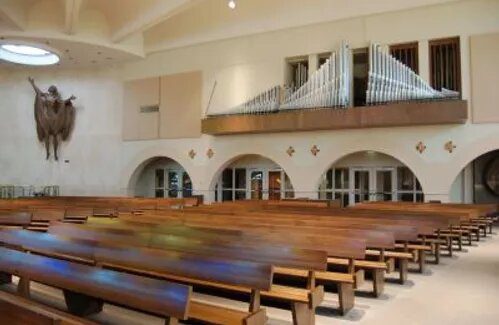
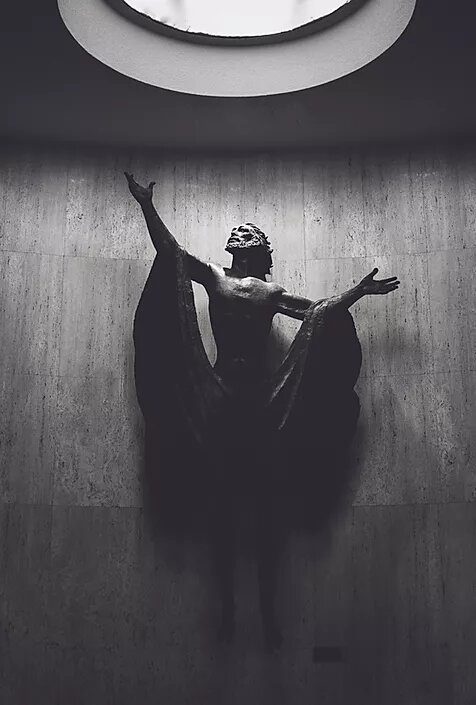
Rising to new heights
The “Risen Christ” bronze sculpture was added to the wall behind the altar in 1982. Created by Italian sculptor Enrico Manfrini, the 14-foot long, 2,200 pound sculpture was anonymously given to the parish by a parish family. The sculpture was custom made for Saint Paul and shipped via freight from Milan, Italy.
1983 marked the 125th Anniversary of Saint Paul Catholic Church. Added to the front lawn of the Saint Paul campus, the 125th Anniversary Cross symbolized the power in the Risen Christ. The cross was fabricated in three pieces and weighed 15 tons. Truly a product of the people of Saint Paul, the cross was designed, engineered and constructed by a large group of volunteers. The cost of all materials was largely donated. “The people gave of their time and talents, they gave of their knowledge and their skills, their brains and their brawn,” said project coordinator Deacon John Roscoe. Much like the steeple of the old gothic church, this cross has come to symbolize the Saint Paul Catholic Community in the modern era.
The Christ Renews His Parish (CRHP) program began at Saint Paul in 1984. Since its inception, hundreds of parishioners have been touched by the Holy Spirit through the annual men’s and women’s weekend retreats.
In 1989 there were 126 baptisms at Saint Paul. The baptismal font was relocated from the church on Chicago Street. It was later replaced upon the church renovation.
A people shining in God’s light
On March 21, 1991 conceptual plans were presented to the parish for a complete renovation of the 1960’s church. Parishioners were invited to a meeting to give feedback. On December 11, 1994 Bishop Dale Melczek celebrated the dedication Mass of the new facilities. The renovations to the 1960’s church were complete. A new social hall, kitchen, chapel and parish offices were added. In addition, the orientation of the church was reversed. The altar and pews were rotated 180 degrees and a new baptismal font was added. At this time 2,500 households were members of Saint Paul.
Upon the retirement of Monsignor Charlebois in 1998, Father Joseph Pawlowski joined us as pastor. Father Joe served as the pastor of Saint Paul until his retirement in June 2018.
The LIFETeen program was established in 1999 by then-Associate Pastor Father Kevin Huber. The 5:30 Sunday evening Mass became the “LIFETeen Mass.” The Mass was structured for teens who listen to contemporary Christian music and participate in “Life Night” activities after Mass.
In 2000 there were 133 baptisms and 61 marriages. 2,602 households were registered members of the parish. 184 students were enrolled at Saint Paul Catholic School and 715 children attended the religious education programs.
In November 2002 the parish held its first Ministry Fair. Sponsored by the newly-formed Stewardship Committee. The fair gave all Saint Paul ministries an opportunity to recruit new members to share their talents with the parish. More than 40 ministries participated in this now-annual event. Children’s Liturgy of the Word was also added to the 5:30 pm Saturday evening and 10:00 am Sunday morning masses.
Committed to the Young Church
In late 2003 final plans were drawn for the 60,000 square-foot Saint Paul Catholic School and Education Center. The new building would be located on the church campus and replace the 1950’s school on Chicago Street. The Center would include designated spaces for LIFETeen, Religious Education, and have enough space for future expansion, plus a full-size gym to host CYO athletic events. The new facility would include a state-of-the-art computer lab and a separate cafeteria. Groundbreaking for the new Education Center was held on October 10, 2004. In 2005 the third Saint Paul Clothing Center was opened with expanded space for the community ministry.
On First Communion Sunday 2006, the $11-million Education Center neared completion. The facility opened its doors to the first students in June 2006 for the last day of the school year. 389 students were enrolled in the 2007-2008 school year. On August 27, 2006 Bishop Dale Melczek dedicated the Saint Paul Education Center. Several hundred parishioners were in attendance to hear Bishop Melczek, Father Joe and Valparaiso Mayor Jon Costas give remarks.
In 2008 Saint Paul marked the 150th Anniversary of Saint Paul.
In June 2018, Father Joe and his longtime Associate Pastor Father Michael Hoffman retired from parish ministry. Father Doug Mayer, who has served in Valparaiso-area parishes since 1986 was appointed administrator, assisted by Father Jeff Burton, who was ordained to the priesthood earlier that same month.
